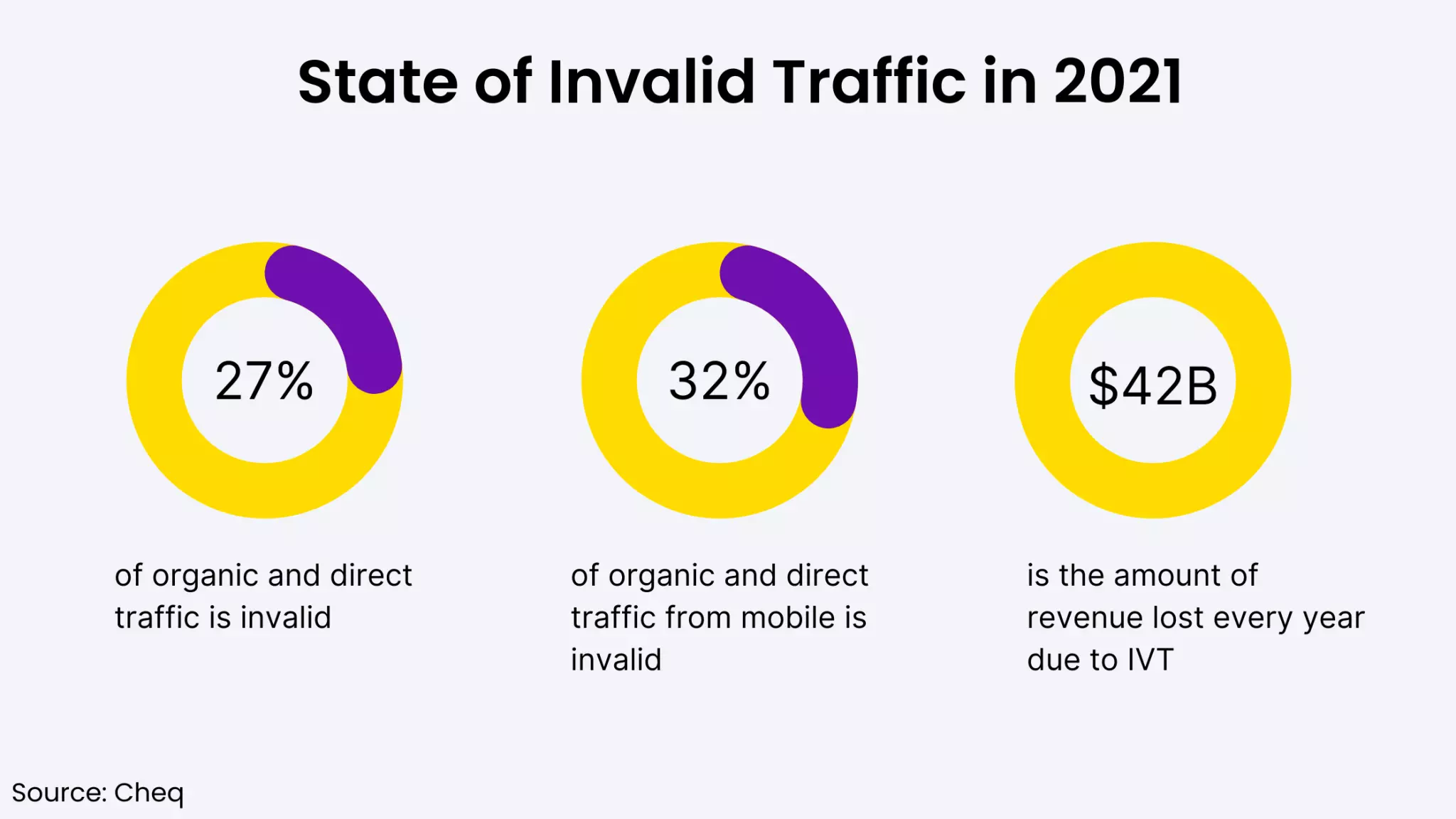As a publisher, you must ensure that your website is trusted well by your audience and advertisers. After all, readers and advertisers are the ones who help in generating revenue from the content and improve your bottom line.
Invalid traffic (IVT) can prevent you from building effective relationships with your readers and advertisers.
Any publisher with quality content and millions of monthly visitors will attract search engine bots and other unsolicited malicious bots.
While search engine bots help you get traffic from search engines (for instance, Google has Googlebot), malicious bots are dangerous for your website as they contribute to a lot of invalid traffic and are designed to carry out numerous illegal activities and fraud.
Without proper attention and preventive measures, you can lose your revenue and readership to invalid traffic. It’s not just you; top media properties also grapple with invalid traffic.
CHEQ, an anti-fraud vendor, reported that 40% of internet traffic is invalid. In this article, we’ll break down what invalid traffic is and the steps you should take to curb them.
Table of Contents
What Is Invalid Traffic?
Invalid Traffic (IVT) is the artificial inflation of impressions and clicks on a publisher’s website, which, in turn, causes an impact on their revenue. It includes non-human traffic and unintended clicks and can be generated deliberately with valueless clicks and impressions. Typically, IVT comprises:
- Impressions and clicks generated by publishers themselves on ads placed on their sites.
- Use of automated tools to create ad impressions and engage with ads.
- Use bot traffic to spam websites for user data theft and other malicious activities.
The EMEA region (Europe, Middle East, and Africa) saw the highest rate of digital advertising fraud or sophisticated invalid traffic in 2021, at 1.6 percent, while the United States and Canada had rates of 1.5 percent.
Types of Invalid Traffic
There are lots of different types of invalid traffic. Not all invalid traffic is created equal, and it’s important to know what each type entails to avoid. Broadly, there are two categories of Invalid Traffic (IVT): General invalid traffic (GIVT) and sophisticated invalid traffic (SIVT).
GIVT – General Invalid Traffic
General invalid traffic is always in the background and is considered the least risky (or acceptable) form of invalid traffic. The crawlers and bots that come from non-threatening sources generate traffic in the GIVT type. Some examples of GIVT include:
- Crawlers and bots coming from known data centers and search engines
- Data and brand safety bots
- Traffic from unknown (but real) browsers
- Analytics crawlers and measurement bots
Though they are non-human hits, all of them serve their purposes. This, in turn, helps the ecosystem to measure, iterate, and improve. And most importantly, GIVT traffic doesn’t engage with ads on your website.
So, do you need to do anything to eliminate them while calculating served ad impressions and revenue?
No.
Most ad serving and tracking systems are sophisticated enough to ignore them by default. For instance, in Google Analytics, you cannot track the pageviews created by spiders and bots in a property.
SIVT- Sophisticated Invalid Traffic
When you hear invalid traffic in a convo, people generally are talking about SIVT. Because SIVT is traffic generated to click/view ads to increase the ad revenue. That’s not all. Fraudsters create SIVT to hijack devices, manipulate location data, spoof domains, and more.
This type of Invalid traffic is not easily detectable because the fraudsters use botnets to work on patterns that would never raise a doubt of non-human activity. SIVT requires proper coordination, advanced analytics, and substantial involvement of humans to identify and analyze fraudulent activities.
This type of traffic is also defined as not meeting the criteria for acceptable ad quality, ad serving, and completeness. Some of the key SIVT examples include:
- Crawlers, bots, and scripts that pretend to be genuine users
- Illegal substitute traffic
- Malware
- Cookie stuffing
- Manipulating measurement of data and statistics with botnets
- The false representation of ads and location data
- Hacked user sessions and devices
- Harvesting & ad stacking
You need to curb SIVT as it impacts your bottom line and credibility.
Why Does Invalid Traffic Exist?
IVT not only influences publisher revenue but also lowers the value of genuine impressions. Let us now understand the five major reasons why invalid traffic hits your website in the first place.
1. Spams
This is nothing but fake user registrations and comments useless to the business or other readers. The spam increases bandwidth and causes overloading on the website servers. This also leads to data theft from comments, feeds, and live chats, ruining brand identity.
2. Audience Extension
Audience extension services can make your website prone to bot activity that leads to invalid traffic.
3. Scrapers
As mentioned in the introduction, any publisher with quality and high-value content on the website is more likely to get attacked by bots and content scrapers. The bots also falsify website analytics and post malicious links that hamper user engagement. This leads to slowing down the website and hampers genuine user visits.
4. Custom programs/botnets
Visitors on a website usually have cookies, and with the help of relevant ads are displayed to those visitors. Fraudsters collect cookies from high-value content websites through programmed bots to steal cookies from high-value sites and artificially increase the value of their ad impressions.
5. Attacks
The bots are programmed to attack the payment systems, resulting in credit card penalties and other charges to publishers. Sometimes it also leads to terminating the merchant account. Bots attack gift coupons, vouchers, or gift cards, causing customer distrust.
Consequences of Invalid Traffic on Publishers
Like it or not, invalid traffic is a thing in the ad-tech world. Guess how much of a thing it is? Cheq reported $42 billion is the amount of lost revenue every year due to IVT.

It’s no secret that ”fake traffic” has been a growing issue for publishers. So, how will you get rid of this thin traffic? The answer to that question lies in understanding the true impact of invalid traffic on publishers.
- Reduced effectiveness of ad campaigns leading to lower click-through rates (CTR) and revenue.
- Damaged reputation and difficulty in establishing relationships with advertisers and readers.
- Low demand for ad inventory in the future.
- Penalty from demand partners (ad networks, SSPs, and exchanges)
How to Find and Eliminate Invalid Traffic (IVT) on a Website?
There is a simple checklist to identify and eliminate IVT on your website:
- Look closely at the reports to drill down to the traffic source and act accordingly. If you’re using a third-party tool (ad verification vendor), you can pull in more details – particular IPs or domains causing the IVT.
- You are more likely to receive invalid traffic using paid traffic sources. Hence, it is important to review your traffic sources. With negligible IVT, you can experiment with multiple paid media to track and measure what works and what the sources are.
- Traffic from the data center may appear legitimate, but sometimes it is confused with an authentic audience when the traffic is invalid. For instance, the Trustworthy Accountability Group (TAG) announced a pilot blacklist. This blacklist comprises data-center IP addresses associated with non-human ad requests. You can use the blacklist to prevent any unnecessary hits.
- When you detect any invalid traffic, speak with your demand partner, as they can help detect anomalies. Our ecosystem transacts billions of impressions every day. With the ad fraud verification/prevention vendors, it is quite easy for you to curb the IVT ad requests to the minimum level.
- Occasionally, anti-fraud tools may flag genuine human traffic as invalid if they can’t identify the source. In that case, you must contact them to ensure your traffic gets passed as legitimate.
- If you have an in-house team dedicated to programmatic advertising, you can try out open-source IVT detection projects like Nemeles.
Wrapping Up
In short, the more you know about invalid traffic and its shady cousin, ad fraud, the better equipped you’ll be to avoid it—which is why we hope this post has been helpful.
Invalid traffic is a growing concern that can affect big publishers or independent bloggers alike, so make sure you’re aware of this problem and take steps to protect yourself. While keeping those machines at bay is easier said than done, avoiding them entirely is the most effective way.
FAQs
How Do I Fix Invalid Traffic?
There are several ways to prevent invalid traffic, such as using fraud detection tools, working with third-party verification companies, and implementing strict ad policies.
What Causes Invalid Traffic?
Invalid traffic can be caused by various factors, including bots and crawlers, click farms, domain spoofing, and click spam.
How Do I Check Invalid Traffic in Analytics?
If you want to verify the presence of invalid traffic in Google Analytics, access your audience report for the previous year and search for sudden traffic surges. If you encounter any irregularities, consult your ad provider and ask for their advice.























